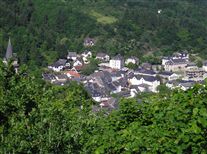Vianden_overview.jpg
Vianden - Click 'Details' for more information
History:
The origins of Vianden date back to the Gallo-Roman age when there was a castellum on the site of the present castle. The original name of Vianden was Viennensis. The first historical reference to Vianden was in 698 when there is a record of a gift in the form of a vineyard in Monte Viennense made by Saint Irmina to the Abbey of Echternach.[1] Vianden possesses one of the oldest charters in Europe, granted in 1308 by Philip II, count of Vianden, from whom the family of Nassau-Vianden sprang, and who was consequently the ancestor of William of Orange.[2]
In the Middle Ages, Vianden's craftsmen were recognised for their skills as tanners, drapers, weavers, barrelmakers, masons, locksmiths and goldsmiths. In 1490, they created guilds for their various trades. Over the years leathermaking became the major industry with the establishment of two tanneries at the end of the 19th century which finally closed in the mid 1950s.
Vianden CastleThe castle was built between the 11th and 14th centuries and became the seat of the counts of Vianden. It was further developed until the 18th century but with the departure of the Counts of Luxembourg to the Netherlands combined with the effects of fire and an earthquake, it slowly deteriorated. The final blow came in 1820 when William I of the Netherlands sold it to a local merchant who in turn sold off its contents and masonry piecemeal, reducing it to a ruin. There were several attempts at restoration but these were hampered by problems of ownership. Victor Hugo lived in the castle for three months in 1871.[3] Not until 1977, when Grand Duke Jean ceded the castle to the State, was it possible to undertake large-scale work, most of which has now been completed.
Vianden is also remembered as the last place in Luxembourg to be freed from the Germans in World War II in February 1945 when the Americans completed Luxembourg's liberation. A memorial to the west of the town, overlooking the castle, commemorates this final battle.
